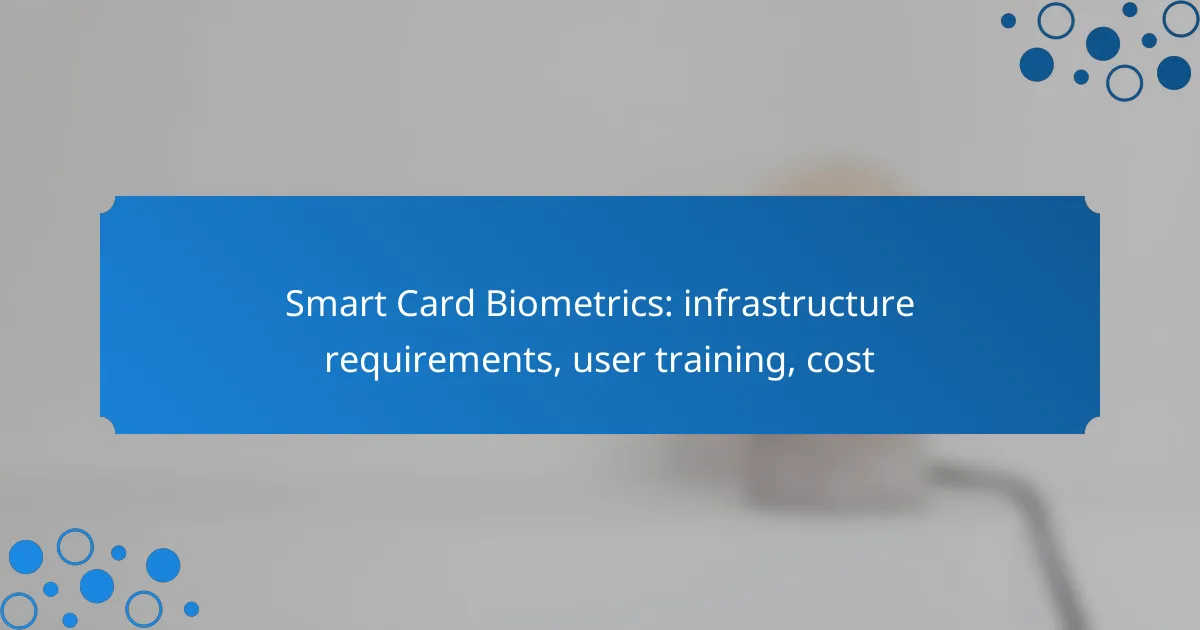Smart Card Biometrics requires a well-established infrastructure, including a robust network, specialized hardware, and compatible software, to function securely and efficiently. User training is essential to familiarize individuals with the technology and its benefits, as well as to address potential troubleshooting issues. Additionally, organizations must consider the varying costs associated with implementation, which can depend on deployment scale and ongoing support needs.

What are the infrastructure requirements for Smart Card Biometrics in Canada?
The infrastructure requirements for Smart Card Biometrics in Canada include a robust network, specific hardware, compatible software, stringent security protocols, and effective integration capabilities. These elements ensure the system operates efficiently and securely, meeting both user needs and regulatory standards.
Network infrastructure
A reliable network infrastructure is essential for Smart Card Biometrics to function effectively. This typically involves high-speed internet connections and secure local area networks (LANs) to facilitate real-time data transmission and authentication processes.
Consider using a combination of wired and wireless connections to enhance flexibility and coverage. Ensure that the network can handle peak usage times without significant latency, aiming for low latency in the range of single-digit milliseconds for optimal performance.
Hardware specifications
The hardware required for Smart Card Biometrics includes card readers, biometric scanners, and servers. Card readers should support various smart card types, while biometric scanners may include fingerprint, facial recognition, or iris scanning devices.
When selecting hardware, prioritize devices that comply with Canadian standards for biometric data capture and processing. Additionally, ensure that the servers have sufficient processing power and memory to handle multiple simultaneous authentications, typically requiring at least 16 GB of RAM and multi-core processors.
Software compatibility
Software compatibility is crucial for integrating Smart Card Biometrics with existing systems. The software must support various operating systems and be able to communicate with different hardware components seamlessly.
Choose software that adheres to industry standards such as ISO/IEC 19794 for biometric data interchange. This ensures that the system can easily integrate with other applications and databases, facilitating smooth operations across platforms.
Security protocols
Implementing robust security protocols is vital to protect sensitive biometric data. This includes using encryption standards such as AES-256 for data at rest and TLS for data in transit to safeguard against unauthorized access.
Regularly update security measures to comply with Canadian privacy regulations, such as the Personal Information Protection and Electronic Documents Act (PIPEDA). Conduct periodic security audits to identify and address vulnerabilities in the system.
Integration capabilities
Effective integration capabilities allow Smart Card Biometrics to work alongside existing systems and processes. This includes compatibility with identity management systems, access control systems, and databases.
When planning integration, consider using application programming interfaces (APIs) that facilitate communication between different software components. This approach can streamline user authentication processes and enhance overall system efficiency.

How to train users for Smart Card Biometrics?
Training users for smart card biometrics involves educating them on how to effectively use biometric authentication systems. This training ensures users understand the technology, its benefits, and how to troubleshoot common issues.
Training programs overview
Training programs for smart card biometrics typically include both theoretical and practical components. Users learn about the underlying technology, security protocols, and the specific hardware they will be using. Programs may vary in duration, often ranging from a few hours to several days, depending on the complexity of the system.
Hands-on sessions are crucial, allowing users to practice enrolling their biometrics and using the smart cards in real-world scenarios. This practical experience helps build confidence and familiarity with the system.
Best practices for user onboarding
Effective user onboarding for smart card biometrics should start with clear communication about the purpose and benefits of the technology. Users should be informed about how biometrics enhance security and streamline access processes.
Providing step-by-step guides and video tutorials can significantly improve the onboarding experience. It’s also beneficial to conduct follow-up sessions to address any questions or concerns that arise after initial training.
Support resources available
Support resources for users of smart card biometrics often include online help centers, FAQs, and user manuals. These resources should be easily accessible and cover common issues such as troubleshooting card readers and managing biometric data.
Additionally, establishing a dedicated support hotline or chat service can provide users with immediate assistance. Regularly updating training materials and support documentation based on user feedback can enhance the overall user experience.

What is the cost of implementing Smart Card Biometrics?
The cost of implementing smart card biometrics can vary widely based on factors such as the scale of deployment, technology chosen, and ongoing support needs. Organizations should prepare for both initial setup costs and ongoing maintenance expenses to ensure a successful integration.
Initial setup costs
Initial setup costs for smart card biometrics typically include hardware, software, and installation expenses. Organizations may spend anywhere from a few thousand to several hundred thousand dollars, depending on the number of users and the complexity of the system. Key components often include biometric readers, smart cards, and enrollment stations.
Additionally, organizations should factor in costs for system integration and any necessary infrastructure upgrades, such as network enhancements or server installations. A thorough assessment of existing systems can help identify potential additional costs.
Ongoing maintenance expenses
Ongoing maintenance expenses for smart card biometrics generally encompass software updates, hardware repairs, and technical support. Organizations should budget for annual maintenance costs that can range from 15% to 20% of the initial setup cost, depending on the service agreements in place.
Training for staff and users is also a critical component of ongoing expenses. Regular training sessions can help ensure that users are comfortable with the technology, which can reduce the likelihood of errors and improve overall system efficiency.
Cost comparison with alternatives
When comparing smart card biometrics to alternatives like traditional passwords or PINs, smart card systems often provide enhanced security but at a higher initial cost. While biometric systems can reduce the risk of unauthorized access, organizations must weigh these benefits against the upfront investment and ongoing expenses.
For example, while a password management system might have lower initial costs, it may incur higher long-term costs due to password resets and potential security breaches. Organizations should conduct a cost-benefit analysis to determine which solution aligns best with their security needs and budget constraints.

What are the prerequisites for adopting Smart Card Biometrics?
To successfully adopt Smart Card Biometrics, organizations must evaluate their existing infrastructure, engage relevant stakeholders, and consider associated costs. These prerequisites ensure a smooth integration of biometric technology into current systems.
Assessment of current systems
Begin by analyzing your existing hardware and software systems to determine compatibility with smart card biometric technology. This includes evaluating card readers, databases, and network capabilities.
Consider conducting a gap analysis to identify necessary upgrades or replacements. For instance, if your current system relies on outdated authentication methods, transitioning to biometric solutions may require significant hardware investments.
Stakeholder engagement
Engaging stakeholders early in the process is crucial for successful implementation. Identify key personnel, such as IT staff, security teams, and end-users, to gather insights and address concerns regarding the new technology.
Facilitate workshops or meetings to discuss the benefits and challenges of smart card biometrics. This collaborative approach helps ensure that all parties are aligned and can contribute to a smoother transition.

How does Smart Card Biometrics compare to traditional methods?
Smart card biometrics enhance security and user convenience compared to traditional methods like passwords and PINs. They utilize unique biological traits for authentication, making unauthorized access significantly more difficult.
Security advantages
Smart card biometrics offer robust security by linking access to an individual’s unique physical characteristics, such as fingerprints or facial recognition. This method reduces the risk of unauthorized access that often accompanies traditional passwords, which can be forgotten, stolen, or easily guessed.
Additionally, smart card systems can incorporate encryption and secure storage of biometric data, further protecting sensitive information. Compliance with standards such as ISO/IEC 19794-2 for biometric data ensures a high level of security across implementations.
User experience differences
Users often find smart card biometrics more convenient than traditional methods. With a simple scan or touch, access is granted quickly, eliminating the need to remember complex passwords or PINs. This streamlined process can reduce login times to just a few seconds.
However, initial setup may require user training to ensure proper usage of the smart card and biometric features. Organizations should provide clear instructions and support to help users adapt to this new technology effectively.
Cost-effectiveness analysis
While the initial investment in smart card biometric systems can be higher than traditional methods, the long-term savings often justify the cost. Reduced incidents of fraud and lower administrative costs associated with password resets can lead to significant financial benefits over time.
Organizations should consider the total cost of ownership, including hardware, software, and ongoing maintenance. In many cases, the return on investment can be realized within a few years, especially in sectors requiring high security, such as finance and healthcare.
